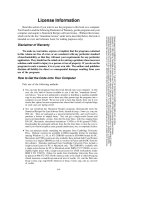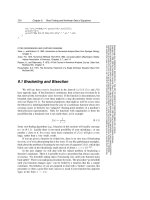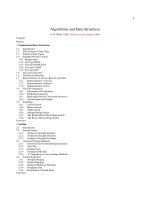Algorithms and Data Structures in C part 2 doc
Bạn đang xem bản rút gọn của tài liệu. Xem và tải ngay bản đầy đủ của tài liệu tại đây (136.13 KB, 6 trang )
which can be written as
where is defined as the unary complement:
The one’s complement of a number, A, denoted by , is defined asFrom Eq. 1.18 it can be
shown that
To see this note that
and
This yields
Inserting Eq. 1.24 into Eq. 1.22 yields
which gives
By noting
one obtains
which is -A. So whether A is positive or negative the two’s complement of A is equivalent to -A.
Note that in this case it is a simpler way to generate the representation of -1. Otherwise you
would have to note that
Similarly
However, it is useful to know the representation in terms of the weighted bits. For instance, -5,
can be generated from the representation of -1 by eliminating the contribution of 4 in -1:
Similarly, -21, can be realized from -5 by eliminating the positive contribution of 16 from its
representation.
The operations can be done in hex as well as binary. For 8-bit 2’s complement one has
with all the operations performed in hex. After a little familiarity, hex numbers are generally
easier to manipulate. To take the one’s complement one handles each hex digit at a time. If w is a
hex digit then the 1’s complement of w, , is given as
The range of numbers in an n-bit 2’s complement notation is
The range is not symmetric but the number zero is uniquely represented.
The representation in 2’s complement arithmetic is similar to an odometer in a car. If the car
odometer is reading zero and the car is driven one mile in reverse (-1) then the odometer reads
999999. This is illustrated in Table 1.2.
Table1.22’sComplementOdometerAnalogy8‐Bit
2’sComplement
Binary Value Odometer
11111110 ‐2 999998
11111111 ‐1 999999
00000000 0 000000
00000001 1 000001
00000010 2 000002
Typically, 2’s complement representations are used in the C++ programming language with the
following declarations:
•char(8bits)
•short(16bits)
•int(16,32,or64bits)
•long(32bits)
The number of bits for each type can be compiler dependent. An 8-bit example of the three basic
integer representations is shown in Table 1.3.
Table1.38‐BitRepresentations8‐BitRepresentations
Number Unsigned
Signed
Magnitude
2’s
Complemen
t
‐128 NR
†
NR 10000000
‐127 NR 11111111 10000001
‐2 NR 10000010 11111110
‐1 NR 10000001 11111111
0 00000000 00000000
10000000
00000000
1 00000001 00000001 00000001
127 01111111 01111111 01111111
128 10000000 NR NR
255 11111111 NRNR
†
.Notrepresentablein8‐bitformat.
Table1.4
Rangesfor
2’s
Complement
and
Unsigned
Notations#
Bits
2’sComplement Unsigned
8 ‐128≤A≤127 0≤A≤255
16 ‐32768≤A≤32767 0≤A≤65535
32 ‐2147483648≤A≤2147483647 0≤A≤4294967295
n
‐2
n‐1
≤A≤2
n‐1
‐1
0≤A≤2
n
‐1
The ranges for 8-, 16-, and 32-bit representations for 2’s complement and unsigned
representations are shown in Table 1.4.
Previous TableofContents Next
Copyright © CRC Press LLC
Algorithms and Data Structures in C++
by Alan Parker
CRC Press, CRC Press LLC
ISBN: 0849371716 Pub Date: 08/01/93
Previous TableofContents Next
1.1.4SignExtension
This section investigates the conversion from an n-bit number to an m-bit number for signed-
magnitude, unsigned, and 2’s complement. It is assumed that m>n. This problem is important
due to the fact that many processors use different sizes for their operands. As a result, to move
data from one processor to another requires a conversion. A typical problem might be to convert
32-bit formats to 64-bit formats.
Given A as
and B as
the objective is to determine b
k
such that B = A.
1.1.4.1SignedMagnitude
For signed-magnitude the b
k
are assigned with
1.1.4.2Unsigned
The conversion for unsigned results in
1.1.4.32’sComplement
For 2’s complement there are two cases depending on the sign of the number:
(a) (a
n - 1
= 0) For this case, A reduces to
It is trivial to see that the assignment of b
k
with









